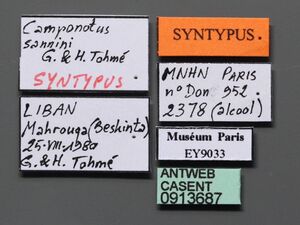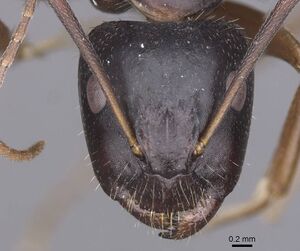Camponotus sannini
| Camponotus sannini | |
|---|---|

| |
| Scientific classification | |
| Kingdom: | Animalia |
| Phylum: | Arthropoda |
| Class: | Insecta |
| Order: | Hymenoptera |
| Family: | Formicidae |
| Subfamily: | Formicinae |
| Tribe: | Camponotini |
| Genus: | Camponotus |
| Species: | C. sannini |
| Binomial name | |
| Camponotus sannini Tohmé, G. & Tohmé, H., 1999 | |
A nest was found under a stone in deciduous mountain forest at an altitude of 514 m. (Borowiec and Salata 2022)
Identification
Ionescu-Hirsch (2009) - C. sannini paratypes are hardly distinguishable from Camponotus aethiops in having a straight propodeal dorsum, as opposed to a variable propodeal dorsum, scape and tibiae with decumbent pubescence, as opposed to apressed, and dark brown mesosoma with very superficial lateral striation, as opposed to a generally darker and matte mesosoma in major workers of C. aethiops. However, specimens from Beirut have a distinctly concave propodeum and scape with apressed pubescence. Furthermore, in the original description of C. sannini completely black nest series are also mentioned.
Keys including this Species
Distribution
Latitudinal Distribution Pattern
Latitudinal Range: 40.5° to 33.536111°.
| North Temperate |
North Subtropical |
Tropical | South Subtropical |
South Temperate |
- Source: AntMaps
Distribution based on Regional Taxon Lists
Palaearctic Region: Greece, Israel, Lebanon (type locality), Syria.
Distribution based on AntMaps
Distribution based on AntWeb specimens
Check data from AntWeb
Countries Occupied
| Number of countries occupied by this species based on AntWiki Regional Taxon Lists. In general, fewer countries occupied indicates a narrower range, while more countries indicates a more widespread species. |

|
Estimated Abundance
| Relative abundance based on number of AntMaps records per species (this species within the purple bar). Fewer records (to the left) indicates a less abundant/encountered species while more records (to the right) indicates more abundant/encountered species. |

|
Biology
Castes
Worker
Images from AntWeb
   
| |
| Syntype of Camponotus sannini. Worker. Specimen code casent0913687. Photographer Will Ericson, uploaded by California Academy of Sciences. | Owned by MNHN, Paris, France. |
   
| |
| Syntype of Camponotus sannini. Worker. Specimen code casent0913798. Photographer Will Ericson, uploaded by California Academy of Sciences. | Owned by MNHN, Paris, France. |
Queen
Images from AntWeb
   
| |
| Syntype of Camponotus sannini. Queen (alate/dealate). Specimen code casent0913799. Photographer Will Ericson, uploaded by California Academy of Sciences. | Owned by MNHN, Paris, France. |
Nomenclature
The following information is derived from Barry Bolton's Online Catalogue of the Ants of the World.
- sannini. Camponotus sannini Tohmé, G. & Tohmé, H. 1999: 477, fig. 2 (w.q.m.) LEBANON.
- Type-material: 10 syntype workers, 25 syntype queens, 3 syntype males.
- Type-locality: Lebanon: Mahrouqa, nr Beskinta village (1220 m.), foot of Mt Sannine (33°57’N, 35°48’E), 25.viii.1980 (Tohmé & Tohmé).
- Type-depository: MNHN.
- Status as species: Vonshak, et al. 2009: 39; Ionescu-Hirsch, 2010: 88; Borowiec, L. & Salata, 2012: 482; Borowiec, L. 2014: 41; Tohmé, G. & Tohmé, 2014: 138; Lebas, et al. 2016: 146; Salata & Borowiec, 2018c: 44; Borowiec, L. & Salata, 2022: 136.
- Distribution: Greece, Israel, Lebanon, Syria.
Unless otherwise noted the text for the remainder of this section is reported from the publication that includes the original description.
Description
Worker
Ionescu-Hirsch (2009) - TL = 6.9–9.4, HL = 1.95–2.42, HW = 1.80–2.34, EL = 0.47–0.48, SL = 1.70–1.88, ML = 2.54–3.05, PW = 1.29–1.52, mTbL = 1.47–1.60, hTbL = 1.91–2.19 (n = 10).
Borowiec and Salata (2022) - Moderately large to large, polymorphic; minor workers HL: 1.194-1.317 (mean 1.247); HW: 0.838-0.960 (mean 0.888); SL: 1.321-1.444 (mean 1.386); EL: 0.341- 0.373 (mean 0.352); ML: 1.92-2.05; MW: 0.78-0.86. Color. Body predominantly brown, mandibles anterior margin of clypeus and gena yellow to yellowish brown, in some specimens mesosoma slightly paler brown than head and gaster, sometimes pronotum yellowish brown and rest of mesosoma pale brown, gaster with yellowish posterior margin; antennae completely yellow to pale brown, legs usually completely yellow or coxa and femora at base indistinctly infuscated by brown. Head. Elongate, 1.3-1.4 times as long as wide, sides in front of eyes straight and parallel, behind eyes regularly softly rounded, posterior margin rounded or in the middle straight. Clypeus pentagonal, in the middle forms rectangular plate protruding anterad, its anterior margin straight, slightly crenulate, on sides anterior clypeal margin deeply emarginate, sides of clypeus strongly converging posterad, straight, posterior margin straight but in the middle shallowly emarginate by frontal triangle, clypeal plate along middle with distinct obtuse keel, whole surface with microreticulation, surface shiny, covered with very sparse and short appressed hairs, anterior margin in the middle with 6 very long setae, on sides with few short additional setae, central plate with several moderately long to long erected setae. Head microreticulate, sculpture in posterior half and sides of head often tends to form transverse or circular striation, on sides of head and in occipital area microsculpture indistinctly diffused, background shiny, covered with sparse and short appressed pubescence, appears partly unhaired, whole surface including gena, sides of head and occipitum with numerous moderately long to long erected setae, ventral side of head with less than 10 moderately long to long erected setae. Scape very elongate, thin, 1.5-1.6 times as long as width of head, slightly, regularly widened from base to apex, its surface microreticulate, slightly dull, with short and sparse appressed pubescence. Funicular segments elongate, thin, first segment approximately 2.7 times as long as wide and 1.4-1.5 times as long as second segment, third segment distinctly longer than second, the rest of funicular segments very elongate. Eyes large, elongate oval, 0.28 length of head. Mandibles stout, diffusely microreticulate and punctate, surface shiny. Mesosoma. Elongate, 2.4-2.5 times as long as wide, dorsally and laterally distinctly sculptured tending to form longitudinal and oblique striation, surface strongly shiny. In lateral view dorsum form regular arch, without mesonotal groove, propodeum never with shallow concavity, posterior face forms with dorsum obtuse angle. Surface of mesosomal dorsum with short and scarce, hardly visible depressed hairs, lateral sides partly unhaired, pronotum with 3-6, mesonotum 2-3, propodeum 3-5 very long erected setae, number of erected setae increases with the size of the ant. Waist and gaster. Petiole in form of broad, thin scale with convex anterior and flat posterior face, apex regularly rounded; surface with distinct transverse striation covered with short and sparse appressed hairs, apical crest with 4-6 very long erected setae. Gaster shorter than mesosoma, tergites with fine transverse microstriation, interspaces without additional microsculpture thus surface of gaster appears strongly shiny, covered with short and scarce appressed hairs; all tergites with 3-6 very long erected setae centrally and a row of long setae on posterior margin, row of short setae on posterior margin moderately elongate, reaching 2/3-3/4 length of the transparent margin, never to the posterior margin of tergite. Legs. Moderately long and thin, hind femora shorter than mesosoma, surface of legs covered with sparse appressed to slightly decumbent hairs, inner margin of tibiae in apical half-length with row of thorns. Ventral surface of fore femora with 3-5 long erected setae.
Major workers: HL: 1.910-2.343 (mean 2.113); HW: 1.612-2.303 (mean 1.967); SL: 1.750-1.958 (mean 1.871); EL: 0.427-0.492 (mean 0.456); ML: 2.64-3.07; MW: 1.25-1.49. In body color and sculpture similar to minor workers but antennal scape often rusty yellow and head appears less shiny than in minor workers. Head stouter, approximately as long as wide, widest in basal ¼ length, sides softly rounded and converging anterad, posterior margin concave; anterior margin of clypeus distinctly crenulate, central plate of clypeus head with more numerous erected setae, gular area with more than 15 short to long erected setae. Scape proportionally shorter, 0.9-1.2 times as long as width of head. Eyes proportionally smaller, 0.22 length of head; mesosoma stouter, 2.1-2.3 times as long as wide, in profile forming more convex arch, propodeum with less obtusely posterior angle. Setation of all mesosomal parts more numerous, pronotum often with more than 10 setae. Ventral surface of fore femora with 5-7 long erected setae.
Taxonomic Notes
Ionescu-Hirsch (2009) - The original description of C. sannini (Tohmé and Tohmé, 1999) refers to Bernard’s (1968) redescription of C. aethiops, in which he mentioned the matte head and black color of C. aethiops specimens from France (Bernard, 1968). However, C. aethiops in its current concept is a variable species, so that the diagnostic characters of C. sannini are weak. A further study of these species from their entire distribution area will clarify the affinities between the Israeli and other specimens.
Determination Clarifications
The species from Lebanon that was formerly identified as Camponotus concavus Forel (junior synonym of C. aethiops in Bolton et al., 2006) by Tohmé (1969a) was reidentified as Camponotus sannini by Tohmé and Tohmé (1999).
References
- Ionescu-Hirsch, A. 2010 (2009). An annotated list of Camponotus of Israel, with a key and descriptions of new species. Israel Journal of Entomology 39: 57-98.
- Borowiec, L. 2014. Catalogue of ants of Europe, the Mediterranean Basin and adjacent regions (Hymenoptera: Formicidae). Genus (Wroclaw) 25(1-2): 1-340.
- Borowiec, L., Salata, S. 2022. A monographic review of ants of Greece (Hymenoptera: Formicidae). Vol. 1. Introduction and review of all subfamilies except the subfamily Myrmicinae. Part 1: text. Natural History Monographs of the Upper Silesian Museum 1: 1-297.
- Tohmé, G.; Tohmé, H. 2000a [1999]. Redescription de Camponotus festai Emery, 1894, et description de C. sannini n. sp., deux fourmis du Liban at de la Syrie (Hymenoptera, Formicidae). Bull. Soc. Entomol. Fr. 104: 473-480 (page 477, fig. 2 worker, queen, male described)
References based on Global Ant Biodiversity Informatics
- Borowiec L. 2014. Catalogue of ants of Europe, the Mediterranean Basin and adjacent regions (Hymenoptera: Formicidae). Genus (Wroclaw) 25(1-2): 1-340.
- Borowiec L., and S. Salata. 2012. Ants of Greece - Checklist, comments and new faunistic data (Hymenoptera: Formicidae). Genus 23(4): 461-563.
- Ionescu-Hirsch A. 2009. An annotated list of Camponotus of Israel (Hymenoptera: Formicidae), with a key and descriptions of new species. ISRAEL JOURNAL OF ENTOMOLOGY 39: 5798.
- Tohmé, G., and H. Tohmé. "Redescription of Camponotus festai Emery, 1894 et description de C. Sannini n. Sp. Deux fourmis du Liban et la Syrie." Bulletin de la Société Entomologique de France 104 (5) (1999): 473-480.
- Vonshak M., and A. Ionescu-Hirsch. 2009. A checklist of the ants of Israel (Hymenoptera: Formicidae). Israel Journal of Entomology 39: 33-55.

